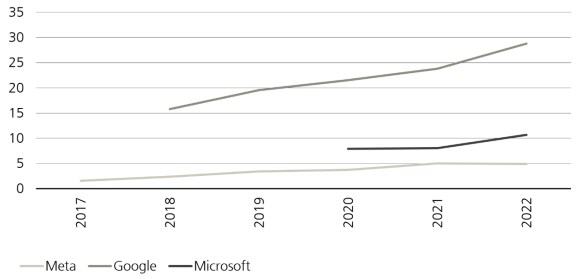Sustainability factors & Investment opportunities
AI's impact on resource efficiency in running buildings and its influence on real estate investment opportunities

Sustainability factors
AI and data centers create thirsty companies due to the vast amounts of water needed for running advanced AI models.¹¹ The large amounts of computing power used needs chilled water to cool equipment by absorbing heat from the air. Some of the water evaporates in the cooling process, while some can be reused.
In 2022, the latest period for which figures are available, Microsoft increased its water withdrawal (the amount of water removed from source) by 33% YoY and Google by 21% YoY, largely as a result of their growing use of data centers (see Figure 1). It is estimated that requesting between 10 and 50 responses from ChatGPT on the GPT-3 version equates to drinking a 500ml bottle of water, with later versions requiring more power and water.1
Figure 1: Big tech water withdrawal (cubic meters, millions)

The computing power used when running AI also consumes significant amounts of energy. For example, according Ami Badani, Chief Marketing Officer of Arm Holdings, a chip design firm, ChatGPT requires 15 times more energy than a traditional web search. She highlighted that AI not only impacts water consumption but also energy consumption. According to the International Energy Agency’s (IEA) analysis of electricity consumption by data centers, AI and the cryptocurrency sector could double between 2022 and 2026.2 It could rise from an estimated 460 TWh in 2022 to more than 1,000 TWh in 2026. According to the IEA, this is roughly equivalent to Japan’s current total consumption.
Google’s total planet-warming emissions in 2023 were 48% higher than in 2019.3 The company attributed the spike to data center energy consumption and rapid advances in the demand for AI. However, Google stated that its data centers are 1.8 times more energy efficient than a typical data center and is committed to using model optimization, efficient infrastructure and emission reduction to mitigate its environmental impact. It’s a similar story for Microsoft which, largely due to its AI activities and construction of data centers, saw its emissions 30% higher in 2023 compared to 2020, even though the firm aims to be carbon negative by 2030. Hence, we believe widespread use of AI is set to drive up energy use.
Not only does AI pose environmental concerns but it can also have social impacts through job displacement. According to the IMF, on a new measure of potential AI complementarity, out of the 60% of jobs exposed to AI in the advanced economies about half may be negatively affected by AI; the rest could benefit from enhanced productivity through the integration of AI.4 Moreover, although the share of jobs exposed to AI is less in emerging markets and developing economies, they are also less ready to reap the benefits of AI. The IMF notes that this could exacerbate the digital divide and cross-country income disparity. Within countries, AI will likely impact income and wealth inequality, as the technology tends to be complimentary to the jobs of higher-wage earners, who can expect a more-than-proportional increase in their labor income.
Within the real estate sector, AI technology can help to improve energy efficiency in buildings and deliver net-zero buildings. AI can be integrated into the design phase of buildings, while predictive maintenance algorithms can extend the lifespan of critical building infrastructure and ensure it operates efficiently, reducing the need for resource-intensive replacements. This can include managing building energy consumption in real time and adapting to occupancy and external environmental conditions. This not only reduces energy costs but can also significantly cut carbon emissions.
AI can also assist in the prediction of environmental transition risk. The World Wildlife Fund has commissioned a tool that utilizes AI, specifically NLP. The tool automates the assessment of companies’ disclosures of transition plans to help reduce inconsistencies and the risk of greenwashing, which has occurred due to the lack of one clear reference framework. This tool highlights the use of AI and machine learning in sustainable finance and how it can help investors assess transition risk and help support companies’ disclosure efforts.
Investment opportunities and transformation of the real estate sector
Overall, we think that AI will have a significant impact on real estate, presenting investment opportunities and changing the ways in which the sector works.
This transformative technology is expected to positively impact the economy and labor market, though some jobs will likely be displaced. The impact on job growth will influence occupier demand and offices in particular. We expect strong growth and long-term investment opportunities in data centers.
AI will also provide opportunities within the real estate investment process to help improve efficiency, performance and analysis. In addition, we think that AI can enhance the sustainability of real estate by reducing energy consumption and carbon emissions. However, this needs to be considered in the context of the significant energy and water consumption requirements of running AI models.
- Artificial Intelligence Insights: What does it mean for real estate?
- AI and real estate investment
- Data centers – the engine room of AI
- AI and offices
- San Francisco and its AI Boom
- Investment decision making and other AI applications
- Investment opportunities and transformation of the real estate sector
Make an inquiry
Fill in an inquiry form and leave your details – we’ll be back in touch.
Introducing our leadership team
Meet the members of the team responsible for UBS Asset Management’s strategic direction.
